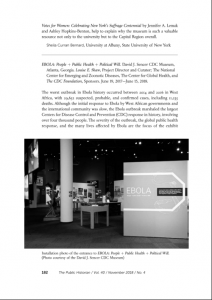Publications
Contours and Constraints of an Autism Genetic Database. Scientific, Social and Digital Species of Biovalue (2018)
This paper examines the scientific, social and digital processes that shape multiple forms of biovalue evident in the development, participation and use of the Simons Simplex Collection (SSC), the largest autism genetic databases in North America. Based on interviews with SSC study participants and investigators, as well as a content analysis of a range of SSC materials, this empirical study makes visible the various contours of biovalue that are entangled between scientists who use this data for autism research, families who donate their blood and medical information to gain access to needed resources, and digital networks of exchange that make hybrid connections between and among these emergent biosocial communities. By examining the production of and interactions between scientific, social and digital forms of biovalue this paper highlights the constraints embedded within this heterogeneous assemblage to offer a critical account of the limits of the SSC and subsequent knowledge production. I contend that while the multi-dimensionality of biovalue built into the fabric of the SSC structure creates various contours of biovalue, it structurally constrains the types of production and knowledge flows that are allowed to be conceived and generated.
Autism Disparities: A Systematic Review and Meta-Ethnography of Qualitative Research (2018)
Racial, ethnic, and socioeconomic disparities associated with autism spectrum disorder (ASD) are evident across many service domains including access to early assessment, diagnosis, and therapeutic interventions. To better understand the complex social and structural factors contributing to these disparities, this article offers a systematic review of peer-reviewed qualitative research conducted from 2010 to 2016 in the United States that investigates autism disparities experienced by marginalized communities. Based on these criteria, we identified 24 qualitative research studies and conducted an analysis using meta-ethnography and an intersectional interpretive lens. We identified three interdependent themes contributing to autism disparities, including familial, cultural, and structural barriers. Omissions in the literature were also evident, including a lack of research on underserved adults with ASD and the gendered inequities of caregiving. We discuss the implications of our findings and offer new questions that take an intersectional approach using qualitative research to investigate autism disparities.
Contextualizing the social and structural constraints of accessing autism services among single black female caregivers (2019)
Autism spectrum disorder (ASD) affects 1 in 59 children and represent the fastest growing developmental disorder in the United States. However, disparities in ASD evaluation, diagnosis, and services exist based on social factors such as race, ethnicity, and socioeconomic status. To date, limited qualitative research has been conducted that focuses on the experiences of single Black female caregivers of children with ASD who live in low-income, minority, and underserved communities in the United States. Objective: This study aimed to understand interrelated social and structural factors that place children and their families with limited resources at risk of delayed ASD diagnostic services and limited therapeutic services. Methods: The study design is based on in-depth interviews conducted with single Black female caregivers of children with ASD who rely on state Medicaid health insurance in metro Atlanta, Georgia (N = 21). A grounded theory analysis of the interviews was used to systematically identify themes and multi-level barriers to ASD services. Results: Despite improvements over the past several decades in diagnosing children with ASD, this study identified multiple and interacting social, economic, and residential barriers to accessing ASD services. Two themes were identified that contextualize barriers to ASD services: bureaucratic processes and geographic location of services. These barriers were compounded by the consequences of being a single female parent, including having limited income, employment options, and social capital. Practical recommendations to break the cycle of ASD service disparities are discussed.
